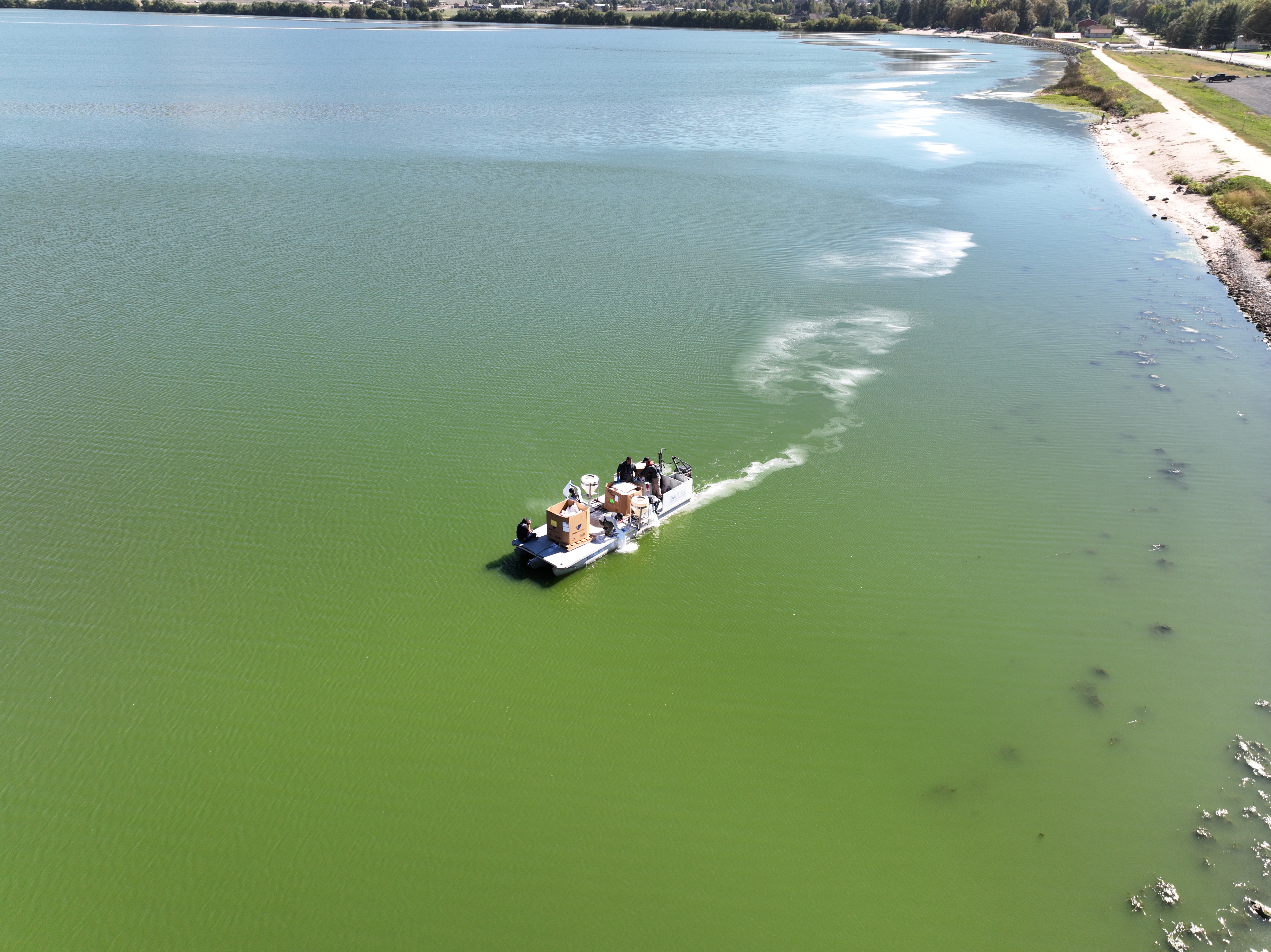Biology
The Human Brain May Contain as Much as a Spoon's Worth of Microplastics, New Research Suggests
The amount of microplastics in the human brain appears to be increasing over time: Concentrations rose by roughly 50 percent between 2016 and 2024, according to a new study
A Sunfish Got 'Lonely' When Its Aquarium Closed for Renovations. Then, Staff Found a Creative Way to Cheer It Up
The solitary fish named Mambo stopped eating and seemed to be missing its human visitors—so aquarists attached photos of human faces and uniforms to the side of its enclosure
Why Do Mammals Have Outer Ears? Scientists Are Getting Closer to Solving the Mystery
Two new studies offer insights into the evolution and development of external ears, which appear in humans and other mammals but aren't found in reptiles, birds or amphibians
How Cleaning Up Harmful Algal Blooms Could Help Fight Climate Change
A company called BlueGreen Water Technologies aims to remove carbon dioxide from the atmosphere while also fighting algae’s toxic effects on people and the environment
Giant, Mysterious Spires Ruled the Earth Long Before Trees Did. What Exactly Are These Odd-Looking Fossils?
For more than 150 years, scientists have debated whether Prototaxites—which stood roughly 24 feet tall and 3 feet wide—were an early lichen or fungus, like a “giant mushroom”
Why Is Every Human Being Riddled With Genetic Errors?
Your body is a collection of cells carrying thousands of genetic mistakes accrued over a lifetime—many harmless, some bad and at least a few that may be good for you
A New Crayfish Species Was Hiding in Plain Sight Among Common Aquarium Pets, Researchers Find
Native to Indonesian New Guinea, the crustacean comes in two color forms and is a popular pet choice in Europe, Japan, the United States and Indonesia
Bats Hitch a Ride on Storm Fronts When Migrating, Saving Energy by 'Surfing' Through the Sky, Study Finds
Researchers tracking female bats in central Europe found they migrated much farther in a single night than previously thought. The findings could help protect bats from wind turbine collisions
The Eight Coolest Inventions From the 2025 Consumer Electronics Show
A needle-free injection system, a bug-watching garden camera, a wearable that helps with memory lapses and more were unveiled at the annual Las Vegas trade show
In a Study on Mice, Scientists Show How the Brain Washes Itself During Sleep
The brain's waste-removal process is "like turning on the dishwasher," a neurologist says, but common sleep medications may harm it
Freshwater Animals Are More Fragile Than Thought, With Nearly a Quarter Threatened With Extinction, Study Finds
Species in Lake Victoria, Lake Titicaca, Sri Lanka’s Wet Zone and the Western Ghats of India are particularly vulnerable to the effects of agriculture, human infrastructure and climate change, per the paper
A Tiny, 'Endangered' Fish Delayed a Dam's Construction in the 1970s. Now, Scientists Say the Snail Darter Isn't So Rare After All
A lawsuit to protect the snail darter from the Tellico Dam in Tennessee offered the first real test of the 1973 Endangered Species Act. But a new study disputes the fish's status as a distinct species
Marlon Brando Wanted to Build a ‘University of the Sea.’ These Scientists Are Bringing the Late Actor’s Vision to Life
On Tetiaroa, a vibrant coral atoll dotted with sandy islets, archaeologists, marine biologists and cultural practitioners are working together to improve understanding of a unique ecosystem
Seven Scientific Discoveries From 2024 That Could Lead to New Inventions
From indestructible tardigrades to body-merging comb jellies, animals can teach humans so much about medicine, robotics, aging and survival
Why Do Some People Thrive on So Little Sleep?
Short sleepers cruise by on four to six hours a night and don’t seem to suffer ill effects
Officials Declare the U.S. Free of 'Murder Hornets' in a Rare Victory Against an Invasive Insect
Five years after the first sighting in Washington state, intense efforts have eradicated the bee-killing hornets from the nation
Meet the Brazilian Velvet Ant, a Rare 'Ultra-Black' Wasp That's So Dark It Absorbs Almost All Visible Light
While the distinctive coloration is thought to be a warning to predators, it also has intriguing implications for designing man-made materials
Scientists Just Dissected the World's Rarest Whale in New Zealand. Here's What They Found
Only seven spade-toothed whales have ever been identified, and the species has never been seen alive. After one washed ashore last summer, researchers have made new discoveries—including that the animal had nine stomach chambers and vestigial teeth
Scientists Warn of an 'Unprecedented Risk' From Synthetic 'Mirror Life,' Built With a Reverse Version of Natural Proteins and Sugars
So-called mirror cells could rampage through our ecosystems, food supply and immune systems, experts say, potentially without existing barriers to protect against them
Scientists Unlock the Secrets of Crocodile Skin and Its Irregular, Mystifying Patterns
The scales on crocodiles’ heads are very different from the skin appendages of other animals and even distinct from the scales on the rest of their bodies
Page 1 of 88
:focal(1920x1097:1921x1098)/https://tf-cmsv2-smithsonianmag-media.s3.amazonaws.com/filer_public/3a/9d/3a9d4ead-68d3-4254-bbc5-ae88fb9ca70e/microplastics-in-lab.png)
:focal(1063x708:1064x709)/https://tf-cmsv2-smithsonianmag-media.s3.amazonaws.com/filer_public/90/ad/90adeeb9-8381-44a3-bf12-4ef859973f69/gettyimages-599834933.jpg)
:focal(3680x2488:3681x2489)/https://tf-cmsv2-smithsonianmag-media.s3.amazonaws.com/filer_public/57/e1/57e18c2a-f005-409d-b580-285e6068fd5d/pexels-diego-f-parra-33199-16878643.jpg)

:focal(492x255:493x256)/https://tf-cmsv2-smithsonianmag-media.s3.amazonaws.com/filer_public/5d/2c/5d2cdeb9-da34-48e0-acb7-2c729e1a1b5b/prototaxites_01.jpg)
:focal(400x301:401x302)/https://tf-cmsv2-smithsonianmag-media.s3.amazonaws.com/filer_public/ae/bc/aebc9f48-7f3b-4200-8527-d60d275394c4/mosaics-1600x600_web.jpg)
:focal(700x467:701x468)/https://tf-cmsv2-smithsonianmag-media.s3.amazonaws.com/filer_public/7f/8a/7f8a5390-5692-41e3-9c7b-889b5417d08c/vodnany_raci_vii_papua__008-1400px.jpg)
:focal(1440x967:1441x968)/https://tf-cmsv2-smithsonianmag-media.s3.amazonaws.com/filer_public/c8/14/c8143db5-05ed-45e9-8a64-a3c513cf970c/bats-surf-storm-fronts.jpg)
:focal(512x344:513x345)/https://tf-cmsv2-smithsonianmag-media.s3.amazonaws.com/filer_public/c0/34/c034baf5-19da-478e-bc41-000cb99d46b8/gettyimages-2192245976.jpg)
:focal(1829x1257:1830x1258)/https://tf-cmsv2-smithsonianmag-media.s3.amazonaws.com/filer_public/73/c9/73c97388-af29-4817-93b7-d33846437641/greg-pappas-ruc9hve-l-e-unsplash.jpg)
:focal(600x400:601x401)/https://tf-cmsv2-smithsonianmag-media.s3.amazonaws.com/filer_public/fa/fd/fafd0bcd-9636-4da1-b3a5-98c98bc7a5e2/crayfish.jpg)
:focal(1024x580:1025x581)/https://tf-cmsv2-smithsonianmag-media.s3.amazonaws.com/filer_public/fe/f9/fef9f6de-f6d5-4c37-a08c-4265cc0aa222/52390992705_7928a72473_k.jpg)
:focal(800x602:801x603)/https://tf-cmsv2-smithsonianmag-media.s3.amazonaws.com/filer_public/f8/d1/f8d1d2d3-a902-4b87-bf28-aa399bb1a496/gettyimages-1086356814_web.jpg)
:focal(1061x707:1062x708)/https://tf-cmsv2-smithsonianmag-media.s3.amazonaws.com/filer_public/b3/5c/b35cff10-8d1d-413b-b05f-af04c0f55eb0/gettyimages-591212519.jpg)
:focal(1782x1205:1783x1206)/https://tf-cmsv2-smithsonianmag-media.s3.amazonaws.com/filer_public/62/d4/62d47569-a84f-46a0-87ac-9adf3d2c8e59/gettyimages-1227833157.jpg)
:focal(250x250:251x251)/https://tf-cmsv2-smithsonianmag-media.s3.amazonaws.com/filer_public/fb/a2/fba29dca-b578-4145-b6a0-7b6518be5e0c/medium_1.jpg)
:focal(533x302:534x303)/https://tf-cmsv2-smithsonianmag-media.s3.amazonaws.com/filer_public/c8/81/c881793a-a7e5-4b38-880a-5c530d7e1f2f/spade-toothed-whale-dissection-hero.jpg)
:focal(2850x1900:2851x1901)/https://tf-cmsv2-smithsonianmag-media.s3.amazonaws.com/filer_public/48/cd/48cd8c49-1f65-489c-909c-2d128448d16a/gettyimages-1703790414.jpg)
:focal(249x297:250x298)/https://tf-cmsv2-smithsonianmag-media.s3.amazonaws.com/filer_public/82/2d/822df92e-385b-4b0e-a4c8-9a48b1b4816e/1024px-nile_crocodile_head.jpg)